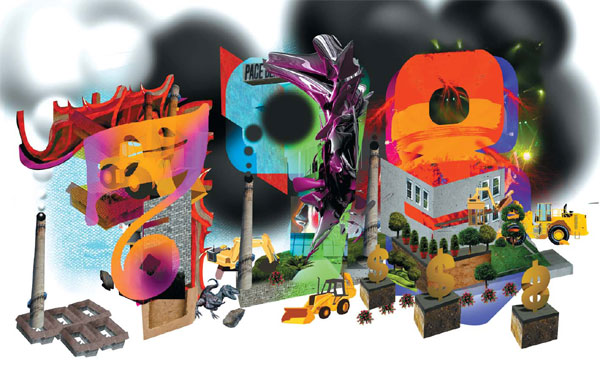The flowing colors of 798 art district
Updated: 2013-09-27 06:59
By Zhang Yuchen (China Daily)
|
||||||||
Area helped to transform Beijing, but now the landscape has changed, as Zhang Yuchen reports.
Huge fashion spreads cover brick walls. Shining steel adorns a maze of pipelines. Both are clear evidence that the days when cavernous concrete ceilings and obsolete machinery used to occupy the site of Beijing's 798 Art Zone have gone.
With the capital's urbanization, the Dashanzi area, which once stood on the outskirts, has become part of the city. Most of the old factories have disappeared.
The zone was transformed with the arrival of artists around 10 years ago in what was billed as a "cradle of contemporary Chinese art".
Huang Rui, one of the pioneers of Chinese contemporary art who was once unofficial spokesman for the 798 arts district, said, "The artists' hub reflected the ebb and flow of the development process, similar to that in the SoHo district of New York, but it has ended up quite differently."
In 2002, Huang came across the factory area and, amazed by the Bauhaus-style space inside the warehouses, decided to stay.

Texan arts book publisher Robert Bernell was the first foreigner from the arts world to arrive at 798, full of passion and enthusiasm for contemporary Chinese art. With belief in his promising artist friends and dynamic works of art, he started his own publishing business, Timezone8, in 2002.
Before moving in, he worked at Lucky Tower on the Third Ring Road in a small, drab office with dismal gray carpet and cheap, gypsum walls. With the need for more space, but with little money, he started to explore factories around Beijing.
In 2000, the Beijing municipal authorities were moving factories out of the city fringes, leaving many industrial areas vacant. These factories had electricity, water and lots of space. They were on key transport routes and were cheap at the time.
After looking at a number of factories, Bernell settled on 798 in 2002. It used to have a Muslim canteen where they made steamed buns and halvah, a dense, nougat-like dessert. The walls were caked with grease, there was a hole in the ceiling to accommodate an emissions vent, but it was only 0.6 yuan per square meter, or 2,000 yuan ($325 a month at today's rates).
At the time, only 20 percent of the factory spaces were occupied. As artists started to work at 798, they also began to meet at Timezone8's coffee shop.
Zheng Kuo, director of 798 Station, an independent documentary about the progress of 798 in the past 10 years, said: "I always remember the atmosphere of freedom in the factory district when I went there for the first time. Factory workers and artists shared the same open space. Everything pointed to it being an ideal place in which to create art."
In many artists' eyes, 798 developed along similar lines as SoHo or Greenwich Village in New York.
Cheap rents
Artists moved in when the rent was cheap, lured by the large, interesting spaces. Like artists in other districts, they fed off each other.
Getting together regularly, putting on events and shows, they became stronger as individuals. This fed 798's growth and it also became a center for writers and movie producers.
"Since 2006, I have witnessed its change on a daily basis," Zheng said. "Every day I see something different at 798."
In recent years many artists have moved away from 798, deterred by high rent increases and a declining market for contemporary Chinese art. They still meet and put on shows, but the fact that too many people try to access them while they're working has also triggered the exodus.
Mao Lizi, who once spent 10 years in France and arrived at 798 with the first group of artists, said: "A significant part of the creation of art happens in the discussions, the interaction, the viewing of exhibition openings that's where ideas are germinated, even refined. The execution in a studio in many ways may not be as important as these other things."
He remembers the days when he and other artists talked and drank outside their studios, most of which have now closed. Last winter, the Timezone 8 bookstore closed and a Japanese sushi restaurant of the same name opened on the site.
With contemporary art requiring artists to focus on topical issues, the germination of Chinese contemporary art can be traced to the Star Art Exhibition in Beijing in 1979.
Against the backdrop of the end of the "cultural revolution" (1966-76) and the start of reform and opening-up in 1978, art was freed from the concept of merely serving politics as it had since the People's Republic of China was founded in 1949.
Starting in the fall of 1979, some 150 pieces of art were displayed at the Star Art Exhibition, including oil paintings, wash paintings, pen-and-ink drawings, wood etchings and carvings, all imitated and borrowed forms of expression from Western Modernism. The exhibition served as a breakthrough for a formerly taboo subject in the late 1970s.
Important role
The role 798 played in promoting Chinese contemporary art is undoubtedly important. Xu Yong, one of the zone's pioneers, said, "Before the appearance of 798 and before Reconstruction 798, Chinese contemporary art was still in a semi-underground state."
Reconstruction 798, a synthetic art event, had an audience of 3,000 in April 2003, hard to imagine today. After this show, Chinese contemporary art began to open up, enjoying closer contact with the public.
The present interaction, which has been sustained relatively well, began with 798. The arrival of the art zone was a sign that the creation of contemporary art and artists' environment had changed from a semi-rural status, when artists lived in the Yuanmingyuan and Songzhuang areas, to a post-industrial status.
Tai Shuangyuan, the manager of He Gallery, which arrived at 798 in 2008, said: "I have never thought about leaving, even if the prospects now appear so gloomy. No other art zone in Beijing can match the environment here."
With the rise of 798, different areas of the country have competed to develop their own art zones.
But Xu is convinced that nothing can replace 798, describing it as the epitome of Chinese art zones.
The district has become the best trading market for contemporary art and the best platform for foreign exchange of contemporary art, not only in the Beijing area, but nationwide and in the Asia-Pacific region.
Media attention
Xu took photographs of Beijing's hutong in the late 1980s and started hutong tourism in the Shichahai area of the capital.
In 2002, he rented a 1,200 square meter space at 798 and set up the 798 Space Gallery. He invested more than 1 million yuan on establishing this, but his lease was only for about three years.
From the start Xu positioned 798 Space as a venue mainly for contemporary art along with some other high-level commercial and cultural activities.
When Xu and Huang organized the Dashanzi International Art Festival in 2004, artists predicted it was inevitable that the 798 district would become like the SoHo area in New York. At the time, they tried hard to turn 798 into a purely cultural space and platform by recommending the arrival of good galleries and institutes.
As 798 has attracted media and public attention, both at home and abroad, it has also become another cultural landmark in Beijing.
Li Xiangqun, a professor at the Fine Arts School at Tsinghua University, submitted a proposal on "retaining an old industrial architectural heritage, retaining a developing art district" to Beijing Municipal People's Congress during the two sessions in 2004.
As a result, the 798 Art Zone received a great deal of attention from the Chaoyang District Government and the Beijing Municipal Government. Coordinating with the Seven Star Group, the Chaoyang government set up the 798 Art Zone management office.
After the office was established, the Chaoyang government invested 120 million yuan on the overall planning of 798.
Roads were built and foundations dug but then, for a year in 2008, all this had to take a back seat with the buildup to, and arrival of, the Beijing Olympics.
Zhang Guohua, executive vice-president of the 798 Art Zone Administrative Committee, regards the zone's rise as an inevitable phase for the cultural sector along with China's social development.
He admits that today's 798 is no longer the ideal place for the creation of art, or the place to display it. "We could attempt to slow the pace of commercialization," he says. "Now, only art-related businesses, such as galleries and design companies, are allowed to settle in the zone."
Frantic negotiations
Up a steep flight of steps in dim evening light, a handful of women are busy with frantic phone-call negotiations at the Thinking Hand Studio, but Huang appears calm and eager to talk about the art zone, which he once initiated and tried to preserve.
In March 2007, on the orders of the Seven Star Group, the property company in the factory district, Huang was refused permission to rent studios, and was forced to move out of the zone.
"Like a speeding train lost to posterity, 798 has already missed out on the chance of standing eternally in the arts world," Huang said, pointing to a declining taste in cultural events and stalls in the art zone recently. "The next step is to know how to guarantee the quality of culture it presents."
Mao, the artist, also suggests that commercial development should take place outside the art zone.
"The value of the art zone needs to avoid being exploited inside but to be established outside," he said. "That is what the government should do."
Contact the writer at zhangyuchen@chinadaily.com,cn
|
Illustration by Guillermo Munro |



|
An exhibition depicting farmers' lives is staged at the 798 Art Zone this summer. Provided to China Daily |
(China Daily USA 09/27/2013 page6)

 Serena Williams back to Beijing for new crown
Serena Williams back to Beijing for new crown
 'Battle of the sexes' to start China Open
'Battle of the sexes' to start China Open
 US astronaut praises China's space program
US astronaut praises China's space program
 Christie's holds inaugural auction
Christie's holds inaugural auction
 Aviation gains from exchanges
Aviation gains from exchanges
 Early fish ancestor found
Early fish ancestor found
 Singers' son sentenced to 10 years for rape
Singers' son sentenced to 10 years for rape
 Djokovic announces engagement to girlfriend
Djokovic announces engagement to girlfriend
Most Viewed
Editor's Picks

|

|

|

|

|

|
Today's Top News
Can the 'Asian pivot' be saved?
Trending news across China
Overseas entrepreneurs connect with reform
Russia to guard Syria chemical weapon destruction
Interpol issues arrest notice for 'white widow'
US astronaut praises China's space program
Wang, Kerry meet second time
China to join talks on trade in services
US Weekly

|

|








